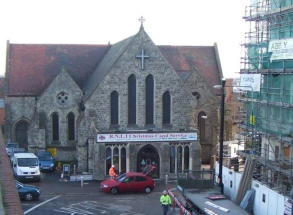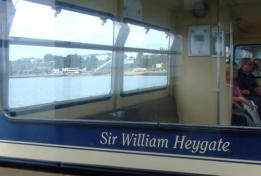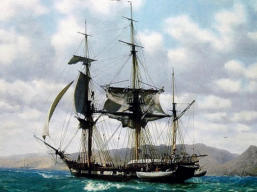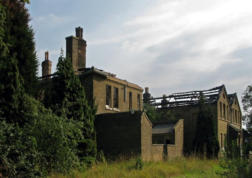Timeline
1840
County
Police
formed.
The
Essex
County
Constabulary
formalised
the
police
throughout
the
county
and
brought
together
up
till
now
Southend's
meagre
contribution
to
law
and
order
which
was
in
the
shape
of
four
constables
distributed
among
the
four
major
populated areas, Prittlewell, Milton, Southchurch and Leigh.
1841
There were 2,339 inhabitants in Southend.
St
John
the
Baptist
Church
is
completed
in
1841.
Today
this
key
Southend
church
is
hidden
behind
the
Palace
Hotel,
but
in
1841
when
it
was
completed
it
had
clear
views
out
across
the
estuary
and
was
an
important
landmark
for
crews
sailing
up
the
estuary.
The
graveyard
has
some
significant
inhabitants
that
would
provide
an
interesting
history
of
Southend
in
itself
with
early
Mayors
of
the
town,
and
a
couple
of
prominent
writers
including
Robert
Buchanan
and
a
memorial
to
Warwick
Deeping,
who
was
born
a
stones throw away in Prospect House on the top of Pier Hill.
1842
St
John
the
Baptist
Parish
Church
opened
on
Pier
Hill.
The
church
of
St.
John
the
Baptist
is
a
building
of
stone
in
mixed
styles,
consisting
of
chancel,
nave,
aisles,
transepts
and
an
organ
chamber.
The
nave
was
built
in
1840
and
aisles
added
later,
the
chancel
was
erected
in
1872-3,
the
chancel
and
transepts
were
enlarged
in
1912
and
a
side
chapel
added
at
a
cost
of
£5,000.
The
reredos
of
alabaster
and
sculptured
stone
was
presented
by
the
Rev.
Francis
and
Mrs
Dormer
Pierce,
and
the
oak
screen,
carved
in
mediaeval
ecclesiastical
style,
was
erected
in
memory
of
the
men
of
the
parish
who
fell
in
the
Great
War,
1914-18.
The
register
dates
from
the
year
1842.
Thomas
Dowsett,
Southend’s
first
Mayor is buried in the churchyard.
Independence
Day.
Southend
had
remained
within
the
jurisdiction
of
the
parish
of
Prittlewell
for
around
fifty
years,
but
in
1842,
on
the
creation
of
the
separate
parish
of
St.
John the Baptist, it attained a measure of independence.
1844
Benjamin Disraeli visits Southend again, and resides at “Porters”, Southchurch Road.
William
Heygate
dies.
Southend
is
well
known
for
the
various
families
that
helped
build
the
town
from
scratch;
one
of
these
that
had
huge
influence
on
Southend
was
the
Heygate
family.
Sir
William
Heygate
reached
heights
of
notoriety
in
other
fields
including
becoming
an
MP
as
well
as
the
distinguished
honour
of
Lord
Mayor
of
London,
on
a
local
front
he
helped
with
the
1829
Southend
Pier
Bill
and
its
promotion
and
passing.
The
Heygate
family
went
on
into
the
early
20th
Century
as
landowners
including
the
ownership
of
Porters,
now
the
Mayoral
house.
Sir
William
Heygate
is
remembered
today
with
his
name
on
one
of
the
latest
pier
trains.
1845
Exploring
the
Northwest
Passage.
In
May
1845
many
excited
locals
watched
as
two
ships
the
Erebus
and
Terror
were
boarded
by
expedition
crews
who
were
heading
out
to
discover
the
Northwest
Passage.
Leading
the
expedition
was
Sir
John
Franklin
who
was
partly
leading
a
Royal
Naval
trip
although
other
monies
were
provided
by
private
sponsorship,
including
financial
help
from
Sir
Bernard
Sparrow
the
Squire
of
Leigh.
Not
all
went
to
plan
with
this
expedition
as
the
people
who
waved
them
off
had
expected
them
back
within
a
couple
of
months.
However,
nearly
two
years
later
and
there
was
no
sign
of
either
ship
and
rescue
expeditions
were
launched
to
try
and
discover
them
with
some
high
rewards
in
place.
The
ships
had
simply
vanished
off
the
face
of
the
earth;
many
years
later
stories
emerged
and
finally
a
narrative
from
a
couple
of
the
ships
officers
indicated
both
vessels
became
trapped
in
the
ice.
Some
of
the
crew
perished
aboard,
others
decided
to
abandon
the
ships
and
make
there
way
south
across
the
ice
on
foot.
It
was
here that the story became gruesome as it became very apparent the shipmates resorted to cannibalism.
1846
The pier finally achieved it's maximum length of a mile and a quarter, complete with horse drawn tramway.
Literary
Society
was
born
at
a
time
when
reading
was
the
key
form
of
personal
entertainment,
it
was
no
surprise
that
the
forming
of
the
Southend
Literary
Society
was
much
welcomed.
The
Society
had
already
a
valuable
library
of
about
1400
volumes,
and
occupied
a
neat
building
on
the
cliffs,
with
semi-circular
front
and
a
spacious
reading
room,
well
supplied
with
London
and
provincial
newspapers, popular periodicals, etc. Mr. W. R. Warwick was the honorary secretary.
1847
Edwin
Arnold
who
gained
literary
notoriety
and
had
previously
lived
in
the
Hamlet
Court,
moved
to
Southchurch
Wick
in
this
year.
This large farm house existed halfway between the White Horse Hotel/Pub and Bournes Green just north of Southchurch Boulevard.
1848
Southend
Pier
Breaks
Records.
Since
1829
when
the
first
foundations
for
the
original
wooden
pier
were
laid
it
was
not
surprising
mainly
to
save
the
blushes
of
the
ladies
getting
their
skirts
wet,
that
it
would
be
extended
and
extended
again
so
much
so
by
1848
became the longest pier in Europe at 7,000ft (2,133.6 m).
1849
20
November.
R.
A.
Jones
was
born,
a
key
man
in
Southend's
development
that
would
reverberate
right
the
way
through
to
today
and
into
the
future.
Robert
Arthur
Jones
became
a
Jeweller
and
more
significantly
a
key
person
in
the
running
of
the
town
by
being
a
significant
benefactor
by
providing
the
town
green
space
that
could
have
been
easily
developed
as
other
parks
in
the
town.
When
the
man
died
in
1925
unprecedented
scenes
of
mourning
were
seen
in
the
streets
of
Southend
as
huge
crowds
gathered
to
watch
the
funeral procession make its way through the High Street to his final resting place in the grounds of Priory Park.
1850
New
water.
The
town
had
become
famous
for
its
natural
waters
and
drinking
fountains
were
established
to
capture
the
pure
waters
running
under
the
streets.
So
it
was
not
too
surprising
to
see
mineral
water
production
companies
setting
up.
The
first
of
its
kind
was
in
1850
was
called
Harringtons
Mineral
Water
Company
Limited.
Originating
in
Rochford,
it
established
itself
in
premises
in
Clarence
Street
and
in
1897
moved
to
London
Road,
coincidentally
at
a
time
when
another
drinks
firm
set-up
called
Ledicotts
Ltd,
noted for its innovative grape-fruit squash.
Peculiar People, this religion was founded in Rochford in 1838, the first chapel was opened in North Road, Prittlewell.
The
famous
ship
that
took
Charles
Darwin
on
his
voyages
of
discovery
lived
on
after
the
scientist
had
finished
his
trips.
Much
speculation
is
a
bound
as
to
what
happened
to
the
famous
Beagle,
but
it
is
known
it
did
take
up
employment
as
a
coastguard
watch
vessel
for
the
Southend
District,
which
covered
the
shoreline
from
Leigh
to
the
River
Crouch.
There
are
several
small
tributaries
that
ran
to
the
Thames
Estuary
from
the
Rivers
Crouch
and
Roach,
and
the
Beagle
for
its
size
did
cause
problems
for
other
river
users,
so
in
1850
the
vessel
was
landed to the side of the river Crouch where it served for another 20 years as a watch vessel.
1851
Southend this year achieved a population of 2,462.
1852
Garrison
builds
up.
The
Officers’
Mess
and
Servant’s
Quarters,
Mess
Road,
were
built
around
a
former
coastguard
station,
part
of
which
is
still
visible.
The
Mess
was
extended
and
altered
several times over the next 50 years.
1853
Billet
club
formed.
Old
Leigh's
fishing
fleet
gained
the
Billet
Club
this
year.
Helping
the
fishermen
who
operated
within
a
mile
of
the
Crooked
Billet
Pub.
In
times
when
a
fisherman
through
illness
could
not
earn
his
keep,
he
could
rely
on
the
Billet
Club
to
help
him
out.
The
rules
of
membership
were
strict
although
for
some
unknown
reason
the
local
policeman
was
also
allowed
to
join
which
caused
the
club some serious financial problems as he did go long term sick and subsequently drained the financial resources.
1854
The
Gas
Company
was
born,
It
was
on
the
27th
January
that
a
dozen
or
so
men
met
in
the
Hope
Tavern,
now
called
the
Hope
Hotel
on
Marine
Parade
Southend.
They
decided
to
hold
a
meeting
to
discuss
the
prospects
of
forming
a
company
that
would
bring
gas
lighting to the town.
Southend
had
a
population
at
this
time
of
around
8,000,
and
visitors
were
making
it
a
favourite
destination
especially
with
a
railway
expected soon, these holidaymakers would hope to enjoy the same brilliant gas-lit streets and houses they enjoyed in London.
1855
Southend
did
not
get
a
supply
of
gas
until
1855,
the
Southend
Gas
Light
&
Coke
Company
having
been
formed
in
the
previous
year.
At
first,
apart
from
the
railway
station,
only
old
Southend
received
a
supply.
Messrs.
Peto,
Betts
&
Co.
tried
to
merge
the
gas
company
with
their
firm,
threatening
in
1861
to
build
their
own
gas
works
to
supply
New
Southend.
Finally
they
gave
in,
laying
the
company's mains and taking its supply in New Southend at an agreed price.
The
train
is
coming.
Leigh
was
reached
in
1855
making
the
trip
to
Southend
a
little
easier,
and
less
dependent
on
other
forms
of
transport. In 1856, the route to Southend by train was accomplished.
1856
National School, Southchurch erected by subscription.
1856 - 1861. Nelson Street (the former High Street to the one we know now) and this area Clifftown, was built.
One
hour
from
London.
Possibly
the
most
significant
development
arrived
in
1856
that
would
make
Southend
the
Londoner's
playground. A full train route was now open and running between London and Southend.
1857
Street
lighting.
Walking
around
Southend
after
dark
caused
many
problems.
The
high
number
of
pubs
fuelled
the
problems
of
people
falling
into
ditches
on
the
way
home.
Also
crime
was
an
issue
and
Southchurch
area
in
particular
was
an
issue
for
young
ladies
walking
through
without
being
attacked.
The
Local
Board
sanctioned
the
erection
of
20
gas
lamps
although
mainly
in
the
Old
Southend area. In 1897 these were replaced by electric equivalents.
1858
Trotters
Theatre
demolished.
Southend's
very
first
theatre
met
the
demolisher’s
in
1858.
The
theatre
began
life
54
years
earlier
built
by
a
man
called
Trotter.
The
venue
became
quite
a
pull
and
would
entertain
most
of
the
higher
class
visitors
and
indeed
pulled
in
some
of
London's
best
actors
and
actresses.
It
is
known
Lady
Hamilton,
loved
the
place
and
frequented
it
regularly.
However,
in
1812
it
was
purchased
and
finally
in
this
year
it
was
demolished
to
make
way
for
a
row
of
cottages.
These
cottages
later
met
a
similar
fate
and
were
knocked
down,
replaced
by
the
gasworks
and
later
the
white
brick
styled
office
block,
which
in
turn
is
now
demolition.
Obviously, what goes around comes around.
1859
3rd
October.
The
first
stone
of
New
Town
Southend,
is
laid,
Messers.
Lucas
Brothers
presented
a
silver
trowel
to
the
Lord
of
the
Manor,
Mr.
D.
R.
Scratton
to
commemorate
the
occasion.
Messrs
Peto,
Brassey
and
Betts
leased
the
land
from
Squire
Scratton
and
together
with
Charles
and
Thomas
Lucas
the
builders,
built
124
town
houses
designed
by
Banks
and
Berry,
Architects
of
Westminster.

Southend Timeline Southend-on-Sea © 2009 - 2024. All Rights Reserved
1840 - 1859




St John the Baptist Parish Church
Pier Train Named Sir William Heygate
Famous Ship Beagle
The Old Garrison



Website Info:

Southend-on-Sea’s No 1 History Website! Documenting The Town & The Townspeople
Now Incorporating The Sea Of Change Website


SOUTHEND CITY
Chalkwell ▪ Eastwood ▪ Leigh-on-Sea ▪ Prittlewell ▪ Shoeburyness ▪ Southchurch ▪ Thorpe Bay ▪ Westcliff-on-Sea
































































